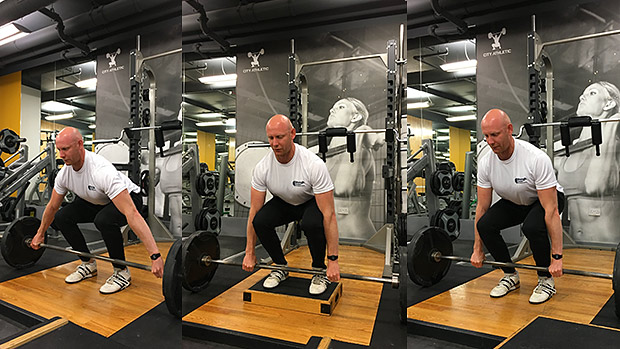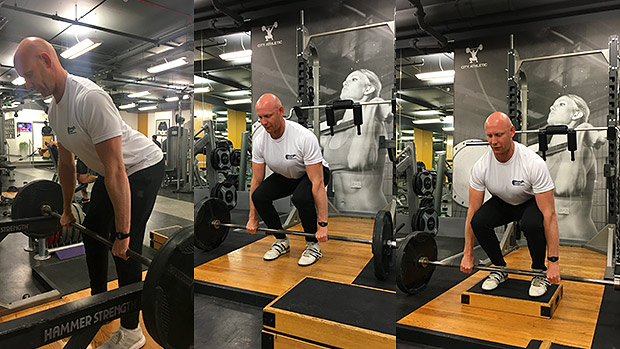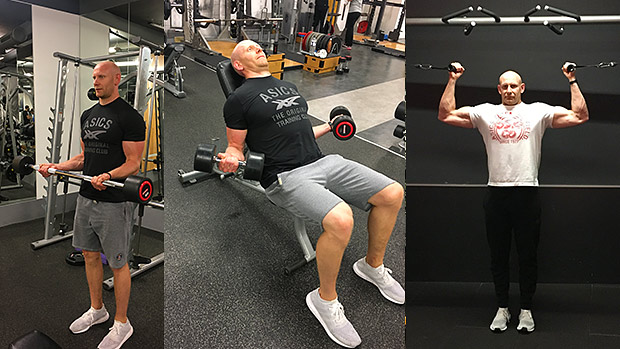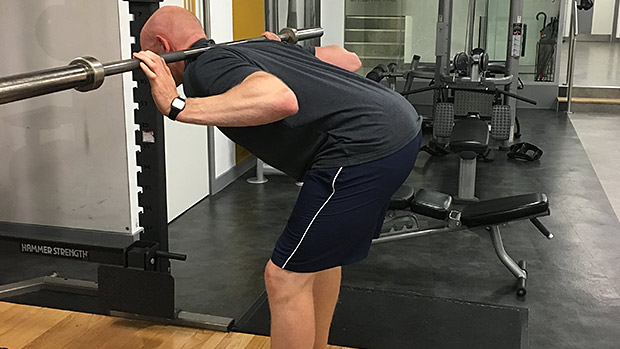Muscle Confusion vs. Strategic Variation
What's the idea behind muscle confusion? Basically, it's that constantly changing your workouts "confuses" your muscles and they have to work harder, which results in better gains. Yeah, too bad that's nonsense.
Muscle confusion, as most people do it, only leaves you tired and weak. Muscle growth quickly stagnates too.
While you can't trick or confuse your muscles, you can provide a varied stimulus that maximizes your gains in strength and size. This is where "strategic variation" comes in. Strategic variation is the art of rotating the exercises in your program for...
- Maximal strength gains
- Optimal muscle building
- Reduced risk of injury
- Peaking for competitive performance
- Bringing up lagging body parts
To fully stimulate a muscle it needs to be worked across its full contractile range and from different angles. Research indicates that even at equivalent training volumes, using multiple exercises is more effective than a single exercise at stimulating a muscle.
This variety doesn't have to happen within one workout, though. Instead it should occur over the course of several training weeks and from one phase of training to the next. By rotating exercises for a specific movement pattern or muscle group, you minimize the staleness that occurs from always hitting the exact same exercises over and over.
A successful training program should be built around a core group of key exercises you rotate over several phases of training. Your variation shouldn't be haphazard or based on the latest fad exercise. Instead, it should fit into your overall plan, complement what has come before it, potentiate what follows, and have a specific purpose.
To review the lifecycle of exercise variation, let's examine the "lifespan" of an exercise as identified by Paul Carter and Christian Thibaudeau in their excellent book, The Maximum Muscle Bible:
- A new movement is added or changed in execution.
- This then creates a new stimulus.
- Over the next few weeks, you gain strength and neural efficiency in that exercise.
- As you adapt, efficiency becomes maximized and strength gains slow down.
- Once efficiency is maximized and the stimulus decreases, fatigue increases in relation to those factors.
Once you reach stage five on an exercise, the return on your investment diminishes and keeps on diminishing while taking an ever-increasing toll on your body. At that point, you should strategically change the exercise to avoid injury and to continue making progress.
While varying exercises is important for muscle growth, doing it too frequently can be counterproductive. You need to allow enough time to master the movement pattern of a specific exercise to be able to sufficiently overload it and provide a growth stimulus.
It takes time for your body to adapt to a stimulus. This isn't on the scale of days, or even weeks, but rather several months. Rotating exercises every 4-12 weeks or so is a good idea.
Keep your big foundational exercises for the duration of a block of training (12-16 weeks on average), but rotate accessory exercises every 4-6 weeks to provide a novel stimulus to the muscle. Here's how it might look for a back training program:
Weeks 1-4
- Pull-Up
- Bent-Over Row
- Seated Face Pull
Weeks 5-8
- Pull-Up (adjust set/rep scheme to provide some novelty)
- Dumbbell Single-Arm Row
- Straight-Arm Pulldown
Weeks 9-12
- Pull-Up (adjust set/rep scheme again)
- Cable Low Row
- Supinated Lat Pulldown
When planning your training, pick 2-3 exercises per body part. Train these with sufficient volume to grow and then rotate them when you transition into your next training phase.
Sports scientists coined the term "phase potentiation" to describe the process by which one block of training increases the effectiveness of the next. Strategic variation is a component of this process. If you vary exercises in an intelligent fashion, then you'll gain strength and muscle faster.
When it comes to building strength, lifters tend to progress in a linear fashion from lighter weights and higher reps to heavier weights and lower reps across a series of phases. Your exercise selection should change in this timeframe, too.
For example, a powerlifter would go from less specific exercise variants (that build the muscles that drive each competition lift) to more competition-specific lifts. Here's a practical example of how this might look for the bench press:
Phase 1:
- Bench Variation: Dumbbell Bench Press
- Triceps Assistance: Dip
Phase 2:
- Bench Variation: Touch n' Go Bench
- Triceps Assistance: Close-Grip Board Press
Phase 3:
- Bench Variation: Competition-Style Paused Bench
- Triceps Assistance: Close-Grip Bench Press
You might also consider using range of motion changes to progress a lift by targeting specific portions of the range. For example, if a lifter was weak off the floor with deadlifts, he might sequence his training like this:

Phase 1:
- Snatch-Grip Deadlift
Phase 2:
- Deficit Deadlift
Phase 3:
- Conventional Deadlift
In both the bench press and deadlift examples the lifter starts with exercises that build the lift and then transitions towards more and more competition-specific lifts. This sequence maximizes results by developing a base of strength and muscle mass in the key body parts for each lift. He then transitions to displaying his strength by practicing the specific skill required in competition.
For muscle gain, this phase potentiation will look a little different. You should strive to accumulate more volume and do more total work over time. For example, you might aim to increase range of motion (ROM) from one phase to the next, which will increase total time under tension (TUT). Here's how it might look:

Phase 1:
- Rack Pull
Phase 2:
- Deadlift
Phase 3:
- Deficit Deadlift
Bodybuilders should also challenge muscles in their fully lengthened, shortened, and mid-range states to maximize muscle growth. You can do this by rotating exercises from one phase to the next. Here's how it might look for training biceps:

Phase 1:
- Barbell Curl (Mid-Range)
Phase 2:
- Incline Dumbbell Curl (Lengthened)
Phase 3:
- High-Cable Curl (Shortened)
And, just to make sure you get it, here's an example using hamstrings (when training hip-extension):
Phase 1:
- 45-Degree Back Extension (Mid-Range)
Phase 2:
- Barbell Good Morning (Lengthened) See photo.
Phase 3:
- Horizontal Back Extension (Shortened)

1 Strategic Variation Reduces Injury Risk
Avoiding injury is one of the best ways to keep getting bigger and stronger. If you can't train, you can't grow. Sensible exercise variation can especially help you avoid overuse injuries.
How many lifters do you know that have the knees of a 6-year old girl or the lower back of a geriatric pensioner, yet feel they need to squat every week? How about the dude who complains of shoulder pain and glass elbows, yet smashes heavy bench presses and skull crushers all the time? Sooner or later these guys are going to end up injured and out of the gym for a long time.
Instead of incessantly grinding away at these lifts (and their joints), they'd be better served by rotating through other exercises. For example, they can use front squats, box squats, hack squats, or even leg presses instead of squats to train their quads.
Similarly, they can do floor presses, dumbbell benches, or incline presses instead of barbell bench presses. All of these exercises will target the muscles they want to stimulate while providing some relief from the persistent pain caused by back squatting or flat barbell benching.
2 It Strengthens Your Weakest Links
In every movement pattern, you'll have a weak link. If your training doesn't address this weak link, the chain will eventually break. The weakest muscle in the chain will either suffer injury or cause you to compensate and cause an injury elsewhere.
Strategic variation can help you fix weak links before they become an issue. Doing so will keep you injury free and keep certain muscles from becoming a limiting factor to your progress.
3 Strategic Variation Lets You Avoid Repetitive Strain Injuries
While muscles are very "plastic" and adapt quickly, our tendons and ligaments have far longer recovery curves. By always doing the same exercises, with the exact same technique, we constantly beat on these structures. Inevitably, they'll break down.
Even subtle changes in exercise selection can sufficiently change the movement pattern, loading sequence, and muscle recruitment to spare you an injury. Just switching from high bar to low-bar squats, or wide grip to mid-grip bench presses, will reduce the chance of an overuse injury.
4 It Lets You Play the Long Game
Since some level of variety is good, your impulse might be use tons of variety in every phase of training. It won't work. If you use every possible variation you can think of in the first phase, it leaves you nowhere to go in subsequent blocks.
For example, if every hamstring session you do deadlifts, Romanian deadlifts, leg curls, glute ham raises, 45-degree back extensions, and lunges, then what will you do for variation down the road?
Taking this scattergun approach to exercise selection means you've hit the muscle from every possible angle (positive), but you've adapted to all these variations and the next phase of training will provide little to no stimulus (negative). If you're not providing an overload stimulus to the body, then you're not growing.
5 Strategic Variation Lets You Do More Volume
The research is pretty clear: Doing more training volume causes more growth, but increasing this volume over time can become problematic if you insist on only doing compound lifts.
Adding volume on these lifts can become unsustainable. Adding in extra sets of squats is brutal and will eventually require a cattle prod. Adding in leg presses or leg extensions, however, can add volume to your quad training while saving the lower back and reducing the amount of psychological arousal required to achieve a training effect.
Use this to your advantage during particularly high-volume blocks. You don't get bonus points for suffering more. Nobody cares how hardcore you are. Results are what matter, so pick exercises strategically to get the job done.





